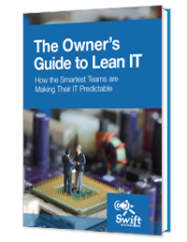
How to Set an IT Budget
Budgets are difficult things.
At their hearts, budgets are about allocating resources – determining what expenditures will provide the most value, and then planning to make them. That can be complex in its own right, but for businesses juggling the demands of growth and the politics of different departments, allocating budgets can be even more complicated.
The reality is that the IT budget is competing for financial attention with other aspects of the business – sales, operations, marketing – and there’s only so much to go around. It can be intimidating to attempt to weigh all factors while pleasing all parties (at least as much as possible).
And yet, it’s essential for your business’ security and functionality that your IT needs are met.
So, how can you set an IT budget that accurately meets your needs without compromising your business?
We’re here to help.
It’s an Investment, Not Just an Expense
First, it helps to frame the IT budget in the proper light: it’s an investment, not just an expense.
That distinction is important, because it’s tempting to view expenditures in the short term, without factoring the return on investment into the equation. But that’s shortsighted, and ultimately inaccurate, because it doesn’t capture true value.
Expenditures on the IT budget ultimately reap dividends in the form of beefed up security, better functioning businesses, and bottom line profit. And skimping on the IT budget ultimately compromises those things.
So, consider your IT budget an investment.
The next question is: how do you make it a good one?
Factors to Consider
The reality is that there is no set-in-stone standard for IT budgeting – the needs of businesses are too varied for that. However, there are a series of factors that should be considered to help your business determine needs and align them with budget allocation.
Those include:
1. Capital Expenditures vs. Operating Expenditures
Is your IT budget going to be composed of capital expenditures, or operating expenditures? Capital expenditures are large up-front payments, while operating expenditures are smaller monthly or yearly payments with a long-term commitment.
As IT moves to the service model, more businesses are choosing to budget for operating expenditures. The value of operating expenditures, of course, is that they tend to come with less risk (and less upfront cost). Due to those factors, they may also be easier to pitch during budget meetings.
2. Necessary Level of Security
Tactically, one of the first factors to consider is the level of security that will be needed for your organization. Questions to ask:
• How will user access be controlled?
• Are you handling sensitive data?
• Are there regulations that you must comply with? For instance, medical organizations must factor in the cost of HIPAA compliance.
It’s important to note that just meeting the minimum security standards is often unwise; the costs of a ransomware attack or data breach are far greater than investing in better security mechanisms.
3. System Accessibility
Related to security is system accessibility. After all, the right people need to be able to access your IT systems – and hackers need to be kept out.
A few considerations:
• How many users will your systems have?
• Will you need to customize user roles and access?
• Where will users be accessing from? For instance, remote workers may require certain configurations that on-premise workers won’t need.
4. Storage Needs
Another factor that will influence budget is storage needs. These can vary greatly based on a host of considerations:
• How much data does your organization process?
• How long does data need to be stored for?
• What systems need to be backed up, and how frequently?
• Does data need to be stored on-premise or in the cloud?
5. Size of the Organization
The size of the organization is one of the more straightforward IT budget considerations to make. Generally, bigger organizations entail more complexity, due simply to the greater number of system components and workstations. However, as a percentage of budget, larger organizations may actually require slightly less spending on IT.
A very general guideline is that mid-sized businesses spend 6 to 7% of their budget on IT, while large companies spend 3 to 4%. Again, though, those numbers are nowhere near set in stone and will vary across businesses and industries.
A few considerations:
• How many workstations are there?
• How many users?
• How many office locations?
6. Future Needs
Last but not least, future needs are essential factors in allocating IT budget. It can be tempting to budget for the short term, allocating only toward immediate needs – but it’s unwise. As an investment, IT needs must be considered in the long-term.
There are two main long-term considerations to make: technology and business growth.
Technology
There’s a common misconception that technological infrastructure is a once-and-done investment – meaning, once you purchase a laptop or server you’re set for six or seven years.
The reality, though, is that technology changes quickly. We recommend refreshing hardware components within a three-year timeframe. Software, too, changes quickly, and updates need to be accounted for in IT budgets.
Business Growth
If your business is growing, the IT solutions that now may not fit next year. Failing to plan for growth can result in issues like network outages, access problems, or even security problems, as your IT systems struggle to carry a burden they weren’t designed to.
We’ve witnessed small businesses go from six people to 25 within the span of a couple of years. The reality is that the systems they start with (Gmail, or consumer versions of cloud applications) simply can’t carry a business past a certain point.
So, don’t limit budget considerations to the immediate context. Make sure to consider future needs.
Choose the Ideal IT Budget
Hopefully, these factors to consider when creating an IT budget will help you to allocate resources in a way that best meets your needs.
If you want to be sure that you’re aligning your budget correctly, don’t hesitate to get in touch. Because the best way to set an ideal IT budget is to work with a managed services IT provider like Swift Systems.
We have the expertise, developed over decades working with businesses throughout the Maryland area, to strategically outline key needs and plan for future growth. Our team of experts can help you to identify the components you’ll need to invest in to make sure your business is primed to function at peak capacity.
In addition to expertise, managed services take the complexity out of IT budgets. Instead of budgeting for fluctuating costs and unknown crises, you can reduce your budget to a single line item that’s the same each and every month.
Budgets can be difficult. But your IT doesn’t have to be. If you’re ready for IT you can count on, it’s time to switch to Swift.

IT systems are foundational to modern businesses. Too often, that foundation is unsteady. Unpredictable outages, insecure networks, and unreliable performance from mission-critical systems can jeopardize your entire business.
There’s a better way. Learn how.
Get in touch with us for a free consultation with one of our technical experts. We’ll review your current systems, assess your needs, and identify the coverage options to best meet them.
Get in touch with us by phone:


